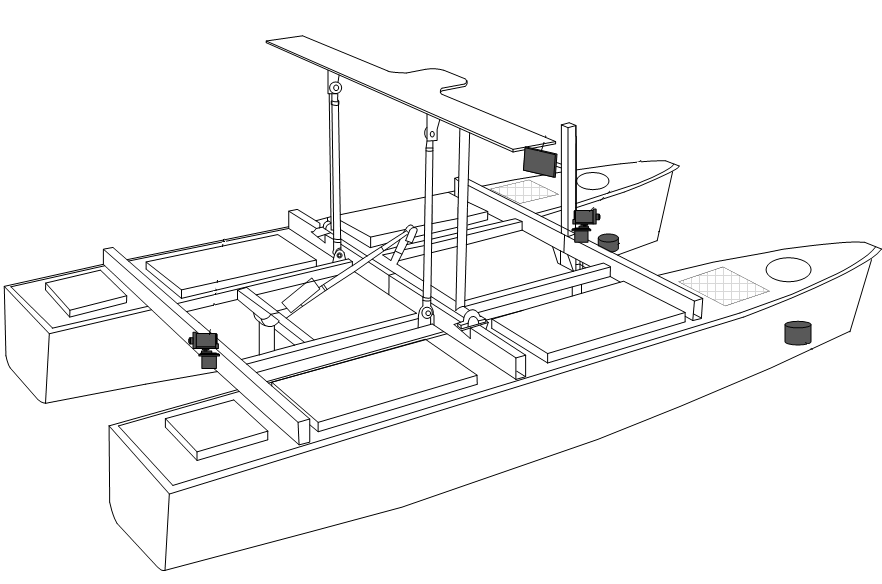HydroDron
The object of the project is to develop an autonomous / remote-controlled multitasking water platform to the implementation of the hydrographic survey missions in the areas of ports, estuaries, anchorages, bays and lakes, rivers and other restricted areas.
The project includes 6 stages that make up the whole process of implementation and platform validation, from the stages defining requirements to projects: deployment of sensors, hull structure, software, navigation system, propulsion module, integration of sensors; building a platform, its validation and development of the methodology of its exploitation.
The results of the project implementation will be implemented in Marine Technology’s own business activity, by commencing the provision of services with the use of a new product developed in the form of a multi-purpose autonomous / remotely controlled surface platform (ASV) and by constructing platforms on request of external customers. The platform will be able to perform measurement missions in limited areas in terms of bathymetric, sonar, LiDAR and other measurements in an autonomous mode, realizing the planned trajectory or in the remote control mode, especially useful in difficult navigation situations.
Platform – HydroDron is characterized by mobility, i. e. it is possible to transport it in the mission area on a car trailer or on a larger surface unit – a base vessel and launch it from a trailer on the beach, shore, jetty, platform or from the base vessel. HydroDron can be used in areas which are inaccessible or difficult to reach for larger crew units, and which may be impossible or uneconomical to use. Such application is particularly important on inland waterways, including the Vistula and Odra, whose importance is one of the priorities of the European Union in the context of efforts to shift cargo from roads and motorways to waterways.
As part of the project, requirements for hull construction and type of drive were developed, and then an unmanned catamaran was made of light durable plastic, with a double hull system (4m long and 2m wide) and with a small immersion from 20cm in the bow part to 50cm in the stern part – the engine, equipped with two electric motors working independently of each other Torqeedo Cruise 4.0 RL of 4kW power each, which provide the appropriate speed and maneuverability.
The platform is equipped with 14 life batteries (3.2V each), placed in two independent battery panels. The battery is additionally charged with 2 photovoltaic panels. This energy ensures that the system operates for up to 12 hours with 710Wh of excess electricity.
HydroDron is characterized by a variety of variants implemented with the help of installation of a wide range of measuring equipment. Its members include, among others:
The navigation sensors are mounted on an automatically folding mast, which ensures safe transport of the unit and access to the measuring area.
The hydrographic head is mounted on a movable actuator enabling remote lifting and lowering of the head and the sound speed profile meter in the water is automatically lowered and lifted by means of a special anchor lift.
The vessel is also equipped with a system of sensors to monitor the situation on and around the platform, in order to increase situational awareness, including two video cameras (rotating and fixed) and a weather station. In addition to typical navigation data, video data, weather information, battery voltage level, mast and cylinder position of the hydrographic head are also recorded. This data is transmitted to the shore station.
The shore station consists of two consoles: a dedicated navigation console with an industrial computer installed in the transport box (and additionally a small shunting console for manoeuvring short distances, including mooring) and a hydrographic console with a Getac computer.
The main hydrographic software used on the platform is HYPACK MAX extended with the addition of HYSWEEP. Thanks to this software, the whole process of hydrographic measurements is ensured, from the planning of measurement works to the development of the final product. Additionally, together with the purchased 3DSS-DX-450 hydrographic equipment from Ping DSP, the manufacturer provided a number of software for data recording and operation of the echo probe. The applications of this software are: 3DSS-DX-Control, 3DSS-DX-Dsiplay, 3DSS-DX-Profile, 3DSS-DX-Converter, 3DSS-DX-Logger.
The film presenting work with the 3DSS-DX-450 system
The first HydroDron tests on the water were carried out with the assistance of a vessel in order to ensure safe navigation in the trial area and to provide the platform with the necessary technical assistance. The tests were carried out in the scope of:
All the tests were successful and the autonomous multi-purpose floating platform HydroDron, made within the project implementation, is an innovative solution on a national scale at least.
Download
Scientific publications related to HydroDron
Address
4/6 Roszczynialskiego St.
81-521 Gdynia
13/5 Niemena St.
81-603 Gdynia
37/5 Klonowica St.
71-248 Szczecin

